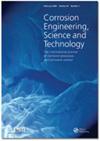Localised corrosion susceptibility of nitrogen-containing type 316LN stainless steel in cold work and thermally aged conditions
IF 1.5
4区 材料科学
Q4 MATERIALS SCIENCE, MULTIDISCIPLINARY
Corrosion Engineering, Science and Technology
Pub Date : 2022-09-29
DOI:10.1080/1478422X.2022.2126407
引用次数: 0
Abstract
ABSTRACT In the present paper, an investigation was carried out to understand the microstructure or secondary phase changes formed during thermal ageing at nose temperature (where Cr diffusion was faster) and its influence on the pitting corrosion behaviour of type 316LN SS with marginally lower Cr in as-received (AR) and 10% cold work (CW). X-ray diffraction studies confirmed Cr23C6 and Cr2N in AR and CW conditions. On thermal ageing, AR material from 0 to 10 h and CW from 10 to 24 h, although with lower Cr, the degree of sensitisation (DOS) and pitting potential (E pit) were insignificant due to nitrogen where as above 10 h in AR condition and below 10 h in CW condition resulted reductions in pitting potential (E pit) in different chloride mediums. These results provide new insights on the interplay between pitting, microstructures, alloying elements.含氮316LN不锈钢在冷加工和热老化条件下的局部腐蚀敏感性
摘要在本文中,研究了在尖端温度(Cr扩散较快)下热老化过程中形成的微观结构或二次相变,以及其对316LN不锈钢点蚀行为的影响,该不锈钢在收到态(AR)和10%冷加工(CW)中的Cr略低。X射线衍射研究证实了Cr23C6和Cr2N在AR和CW条件下。关于热老化,AR材料从0到10 h和CW从10到24 h、 尽管铬含量较低,但由于氮含量高于10,敏化程度(DOS)和点蚀电位(E坑)并不显著 AR条件下的h和低于10 在CW条件下的h使不同氯化物介质中的点蚀电位(E坑)降低。这些结果为点蚀、微观结构和合金元素之间的相互作用提供了新的见解。
本文章由计算机程序翻译,如有差异,请以英文原文为准。
求助全文
约1分钟内获得全文
求助全文
来源期刊

Corrosion Engineering, Science and Technology
工程技术-材料科学:综合
CiteScore
3.20
自引率
5.60%
发文量
58
审稿时长
3.4 months
期刊介绍:
Corrosion Engineering, Science and Technology provides broad international coverage of research and practice in corrosion processes and corrosion control. Peer-reviewed contributions address all aspects of corrosion engineering and corrosion science; there is strong emphasis on effective design and materials selection to combat corrosion and the journal carries failure case studies to further knowledge in these areas.
 求助内容:
求助内容: 应助结果提醒方式:
应助结果提醒方式:


